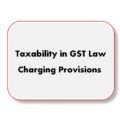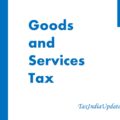TDS Mechanism under GST; Under the GST regime, section 51 of the CGST Act, 2017 prescribes the authority and procedure for ‘Tax Deduction at Source’. The Government may order the following persons (the deductor) to deduct tax at source:
(a) A department or establishment of the Central Government or State Government; or
(b) Local authority; or
(c) Governmental agencies; or
(d) Such persons or category of persons as may be notified by the Government on the recommendations of the Council.
The tax would be deducted @1% of the payment made to the supplier (the deductee) of taxable goods or services or both, where the total value of such supply, under a contract, exceeds two lakh and fifty thousand rupees (excluding the amount of central tax, State tax, Union territory tax, integrated tax and cess indicated in the invoice). Thus, individual supplies may be less than Rs. 2, 50,000/-, but if contract value is more than Rs. 2, 50,000/-, TDS will have to be deducted. However, no deduction shall be made if the location of the supplier and the place of supply is in a State or Union territory which is different from the State, or as the case may be, Union territory of registration of the recipient. This can be explained in the following situations.
a) Supplier, place of supply and recipient are in the same state. It would be intra-state supply and TDS (Central plus State tax) shall be deducted. It would be possible for the supplier (i.e. the deductee) to take credit of TDS in his electronic cash ledger.
b) Supplier as well as place of supply are in different states. In such cases, integrated tax would be levied. TDS to be deducted would be TDS (Integrated tax) and it would be possible for the supplier (i.e. the deductee) to take credit of TDS in his electronic cash ledger.
c) Supplier as well as place of supply are in State A and recipient is located in State B. The supply would be intra-State supply and Central tax and State tax would be levied. In such case, transfer of TDS (Central tax + State tax State B) to the cash ledger of the supplier (Central tax + State tax of State A) would be difficult. So in such cases, TDS would not be deducted.
Thus, when both the supplier as well as place of supply are different from that of the recipient, no tax deduction at source would be made.
Registration of TDS deductors: A TDS deductor has to compulsorily register without any threshold limit. The deductor has a privilege of obtaining registration under GST without having required to obtain PAN. He can obtain registration using his Tax Deduction and Collection Account Number (TAN) issued under the Income Tax Act, 1961.
Deposit of TDS with the government: The amount of tax deducted at source should be deposited to the Government account by the deductor by 10th of the succeeding month. The deductor would be liable to pay interest if the tax deducted is not deposited within the prescribed time limit.
TDS Certificate: A TDS certificate is required to be issued by deductor (the person who is deducting tax) in Form GSTR-7A to the deductee (the supplier from whose payment TDS is deducted), within 5 days of crediting the amount to the Government, failing which the deductor would be liable to pay a late fee of Rs. 100/- per day from the expiry of the 5th day till the certificate is issued. This late fee would not be more than Rs. 5000/-. For the purpose of deduction of tax specified above, the value of supply shall be taken as the amount excluding the central tax, State tax, Union territory tax, integrated tax and cess indicated in the invoice.
For instance, suppose a supplier makes a supply worth Rs. 1000/- to a recipient and the GST @ rate of 18% is required to be paid. The recipient, while making the payment of Rs. 1000/- to the supplier, shall deduct 1% viz Rs. 10/- as TDS.
The value for TDS purpose shall not include 18% GST. The TDS, so deducted, shall be deposited in the account of the government by 10th of the succeeding month. The TDS deposited in the government account shall be reflected in the electronic cash ledger of the supplier (i.e. deductee) who would be able to use the same for payment of tax or any other amount. The purpose of TDS is just to enable the government to have a trail of transactions and to monitor and verify the compliances.
TDS Return: The deductor is also required to file a return in Form GSTR-7 within 10 days from the end of the month. If the supplier is unregistered, the name of the supplier rather than GSTIN shall be mentioned in the return. The details of tax deducted at source furnished by the deductor in FORM GSTR-7 shall be made available to each of the suppliers in Part C of FORM GSTR-2A electronically through the Common Portal and the said supplier may include the same in FORM GSTR-2. The amounts deducted by the deductor get reflected in the GSTR-2 of the supplier (deductee). The supplier can take this amount as credit in his electronic cash register and use the same for payment of tax or any other liability.
Consequences of not complying with TDS provisions:
| S/ No. |
Event |
Consequence |
|
1. |
TDS not deducted |
Interest to be paid along with the TDS amount; else the amount shall be determined and recovered as per the law. |
|
2. |
TDS certificate not issued or delayed beyond the pre- scribed period of five days | Late fee of Rs.100/- per day subject to a maximum of Rs.5000/-. |
|
3. |
TDS deducted but not paid to the government or paid later than 10th of the succeeding month | Interest to be paid along with the TDS amount; else the amount shall be determined and recovered as per the law. |
|
4. |
Late filing of TDS returns | Late fee of Rs.100/- for every day during which such failure continues subject to a maximum amount of five thousand rupees. |
Tax Collection at Source (TCS) has similarities with TDS, as well as has distinctive features also. TDS refers to tax which is deducted when recipient of goods or services makes some payments under a contract etc. while TCS refers to tax which is collected by the electronic commerce operator when a supplier supplies some goods or services through its portal and the payment for that supply is collected by the electronic commerce operator. We will discuss the exact nature of TCS with an example. There are many e-Commerce operators [hereinafter referred to as an Operator], like Amazon, Flipkart, Jabong, etc. operating in India. These operators display / list on their portal products as well as services which are actually supplied by some other person to the consumer. The goods or services belonging to other suppliers are displayed on the portals of the operators and consumers buy such goods/services through these portals. On placing the order for a particular product/ services the actual supplier supplies the selected product/services to the consumer. The price/consideration for the product/services is collected by the Operator from the consumer and passed on to the actual supplier after deducting his commission by the Operator.The Government has placed the responsibility on the Operator to collect the ‘tax’ at a rate of 1% from the supplier. This shall be done by the Operator by paying the supplier the price of the product/services, less the tax, calculated at the rate of 1%. The said amount will be calculated on the net value of the goods/ services supplied through the portal of the operator.
Suppose a certain product is sold at Rs. 1000/- through an Operator by a seller. The Operator would deduct tax @ 1% of the net value of Rs. 1000/- i.e. Rs. 100/-.Let us have a look at the statutory provisions relating to TCS.
Registration: The ecommerce operator as well as the supplier supplying goods or services through an operator need to compulsorily register under GST. The threshold limit of Rs. 20 lakhs (10 lakhs for special category states) is not applicable to them. Section 24(x) of the CGST Act, 2017 makes it mandatory for every e-Commerce Operator to get registered under GST. Similarly, section 24(ix) of the CGST Act, 2017 makes it mandatory for every person who supplies goods/services through an Operator to get registered under GST.
Power to collect tax: Section 52 of the CGST Act, 2017 provides for Tax Collection at source, by e-Commerce operator in respect of the taxable supplies made through it by other suppliers, where the consideration in respect of such supplies is collected by him.
TCS Statement: The amount of tax collected by the operator is required to be deposited by the 10th of the following month, during which such collection is made. The operator is also required to furnish a monthly statement in Form GSTR-8 by the 10th of the following month. The Operator is also required to file an Annual statement in prescribed form by the 31st of December following the end of every financial year. The Operator can rectify errors in statements filed, if any, latest by the return to be filed for the month of September, following the end of every financial year.
The details furnished by the operator in GSTR-8 shall be made available electronically to each of the suppliers in Part C of FORM GSTR-2A on the Common Portal after the due date of filing of FORM GSTR-8.
Credit of tax collected: The tax collected by the operator shall be credited to the cash ledger of the supplier who has supplied the goods/services through the Operator. The supplier can claim credit of tax collected and reflected in the return by the Operator in his [supplier’s] electronic cash ledger.
Matching of details of supplies: The details of the supplies, including the value of supplies, submitted by every operator in the statements will be matched with the details of supplies submitted by all such suppliers in their returns. If there is any discrepancy in the value of supplies, the same would be communicated to both of them. If such discrepancy in value is not rectified within the given time, then such amount would be added to the output tax liability of such supplier.
The supplier will have to pay the differential amount of output tax along with interest.
Notice to the Operator: An officer not below the rank of Deputy Commissioner can issue notice to an Operator asking him to furnish details relating to volume of goods/ services supplied, stock of goods lying in warehouses/ godowns, etc. The Operator is required to furnish such details within 15 working days. In case an Operator fails to furnish the information, besides being liable for penal action under section 122 shall also be liable for penalty up to Rs. 25,000/-.
The GST Council in their 22nd meeting held on 6th October, 2017 at New Delhi decided that operationalization of TDS/ TCS provisions shall be postponed till 31.03.2018.




